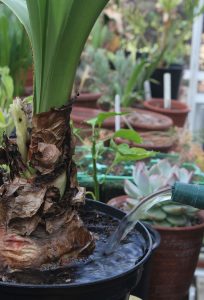
The erratic weather continues to preoccupy our gardening thoughts, with hot sunshine and cold drying winds over much of UK and barely enough rain, in most areas, to top up the water butt.
Check your pots twice a day and water if necessary, make sure tomatoes are moist. Erratic watering causes fruit splitting. Pinch out the side shoots with your finger and thumb. (See June)
Ensure good ventilation from early in the morning before the greenhouse heats up. Open the ventilation on the leeward side of the greenhouse to prevent plants being chilled by the cold, gusty winds and dampen the greenhouse paths or floor to improve humidity during extended periods of sunshine.
Feed fruiting plants like tomatoes, sweet peppers, chilli’s and aubergines, weekly with high potash tomato fertiliser.
Train the stems of cucumbers up supports like netting or canes and pinch out the side shoots two leaves beyond a flower or developing fruit. Keep them well-watered with tepid water and mulch to reduce the risk of mildew. It helps to grow resistant varieties like ‘Carmen’. Harvest regularly when the fruits are about 12” long.
Once tomatoes have set their fourth or fifth truss of developing fruit, cut off the main stem, one leaf above the terminal truss, so the moisture and nutrients are focussed on swelling and ripening the fruit. Tap the open flowers to encourage pollination and tie the stems to canes or supporting string as they grow.
In southern Britain and where you have a warm garden microclimate, make a last sowing of runner and French beans for early autumn cropping.
The following can be sown in July: Basil, Coriander and Dill, French beans and Florence fennel. These can be grown in pots or modules or planted out in the greenhouse border.
Check for red spider mite, and whitefly, particularly on cucumbers and aubergines. Both can be managed using biological controls. Red spider (or two spotted) mite dislikes humid conditions so mist plants regularly with tepid water to maintain humidity around the plants. (See June for Biological controls)
Feed citrus with summer fertiliser, keep away from draughts and keep the compost moist with tepid rainwater. Tap water will suffice if your water butt runs dry.
Consider using ‘grey’ water from the shower, bath, kitchen or from the washing machine rinse cycle on ornamental plants in the greenhouse. Keep detergent levels like shower gel to a minimum and don’t store grey water for longer than 24 hours. Softened tap and dishwasher water are useful but as a temporary measure and don’t use water containing bleach and disinfectants. Learn to water effectively, around the base of the plant so the water reaches the roots, not over the leaves, learn to estimate how much each pot needs. Store your watering cans under the bench to catch the drips draining from the bench. If you have to carry the can from tap to greenhouse you are more careful with the water you use; slightly underfill so you don’t spill any. Keep your greenhouse pots and borders weed free, so the plants, not weeds use the water. When your water butt finally fills again, flush out the compost with fresh, warmed rain water.
Happy gardening. Matt


